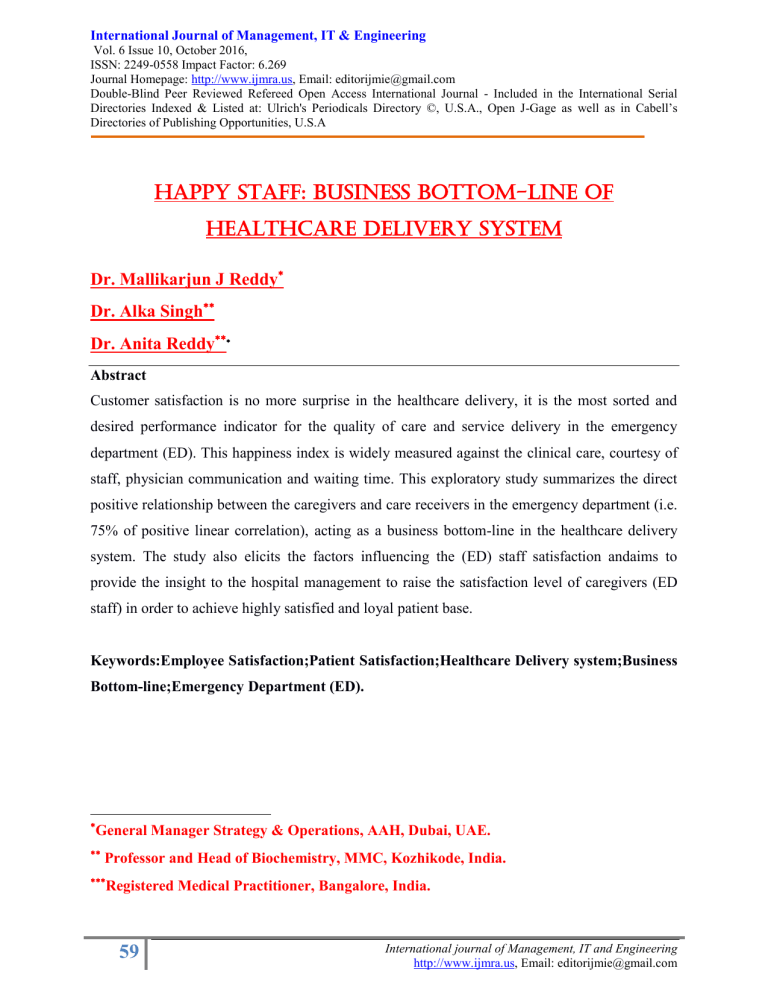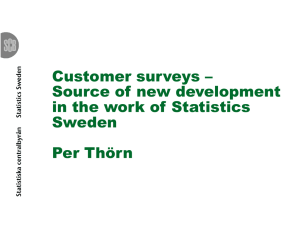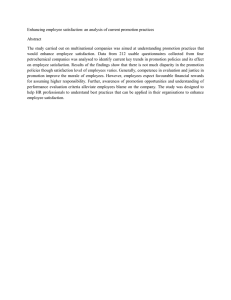IJMRA-10514
advertisement

International Journal of Management, IT & Engineering Vol. 6 Issue 10, October 2016, ISSN: 2249-0558 Impact Factor: 6.269 Journal Homepage: http://www.ijmra.us, Email: editorijmie@gmail.com Double-Blind Peer Reviewed Refereed Open Access International Journal - Included in the International Serial Directories Indexed & Listed at: Ulrich's Periodicals Directory ©, U.S.A., Open J-Gage as well as in Cabell‟s Directories of Publishing Opportunities, U.S.A Happy staff: Business Bottom-line of Healthcare Delivery System Dr. Mallikarjun J Reddy Dr. Alka Singh Dr. Anita Reddy Abstract Customer satisfaction is no more surprise in the healthcare delivery, it is the most sorted and desired performance indicator for the quality of care and service delivery in the emergency department (ED). This happiness index is widely measured against the clinical care, courtesy of staff, physician communication and waiting time. This exploratory study summarizes the direct positive relationship between the caregivers and care receivers in the emergency department (i.e. 75% of positive linear correlation), acting as a business bottom-line in the healthcare delivery system. The study also elicits the factors influencing the (ED) staff satisfaction andaims to provide the insight to the hospital management to raise the satisfaction level of caregivers (ED staff) in order to achieve highly satisfied and loyal patient base. Keywords:Employee Satisfaction;Patient Satisfaction;Healthcare Delivery system;Business Bottom-line;Emergency Department (ED). General Manager Strategy & Operations, AAH, Dubai, UAE. Professor and Head of Biochemistry, MMC, Kozhikode, India. Registered Medical Practitioner, Bangalore, India. 59 International journal of Management, IT and Engineering http://www.ijmra.us, Email: editorijmie@gmail.com ISSN: 2249-0558 Impact Factor: 6.269 1. Introduction In healthcare delivery system patient consumes services on his or her physical body through the involvement of a variety of professionals, extensive use of materials and equipment, making care delivery process as cross-functional& non-linear, clinical urgency and criticality make the environment much more complex. In the care cycle, notably all treatments and procedures are administered by people and technology supporting the skilled staff to be more efficient. It‟s true that the most dramatic improvements in healthcare are achieved through people than the technology; so it‟s desired to have such positively contributing employees. In an established super-specialty hospital setup manpower expenses alone could mark up to 60% of the revenue generated; ever increasing demand for the health care services and a relative shortage of clinical professionals makes it more challenging to maintain the relative cost center margin within limits; So, Healthcare organizations are increasingly looking beyond the financial performance measures and agree to retain the existing clinical staff through collaborative approach over competitive structure, which not only saves the recruitment cost, in longer runs it also boosts the employee morale and service delivery prospects along with committed employment. This study takes the opportunity to explore the satisfaction levels of Accident & Emergency department (ED) employees in a super-specialty hospital to determine the extent to which employee satisfaction relates to the quality of the patient experience and provides a positive insight towards employee satisfaction through empirical analysis. This study also providesthe several insights to the management for creating and retaining the satisfied employees through positive encouragements and monetization practices. 2. 2.1 Research Method Objectives of the Research a. To assess the employee satisfaction and patient satisfaction levels b. To assess the correlation between employee satisfaction and patient satisfaction c. To assess the factors influencing the employee satisfaction 60 International journal of Management, IT and Engineering http://www.ijmra.us, Email: editorijmie@gmail.com ISSN: 2249-0558 Impact Factor: 6.269 2.2 a. Materials and Methods Research Setting: The study was conducted in the functioning Super-specialty Corporate Hospital at Bangalore, India for the duration of six months b. Study Design: It‟s an exploratory research study conducted by using defined feedback system through questionnaires and direct interactions. c. i. Sample Design Population: Population chosen for the study were the Accident & Emergency Department (ED) staff and the patients. ii. Sample size: 1. Staff: Enumerative sample (across all category of staff in the ED) 2. Patient: 2500 patients feedback was collected during the study period iii. Sampling Technique: For the purpose of the study, convenience sampling technique has been used to represent the population. Instrumentation technique: The standard questionnaire was used for the survey. Likert‟s 5 iv. Ranking scale has been used to score the satisfaction levels; where 5 being the „highly satisfied‟ and 1 being the „not satisfied‟. v. Data Collection: Primary data was collected through direct survey method from patients and staff. Subjective opinions were also collected through the direct discussion from the sample population. vi. Data Analysis: Relative statistical analysis like measures of central tendency, measures of dispersion and correlation analysis were performed, Phase 1: Satisfaction levels and their interdependency Phase 2: Exploring the factors which influenced the satisfaction. 3. Results and Analysis Obtained data was analyzed in a phasic manner; Phase 1 - Exploring the Employee and Patient Satisfaction levels and their interdependency and Phase 2 – details about the factors influencing. Phase 1: Satisfaction levels and their Interdependency Table 1: Employee and Patient Satisfaction levels distribution 61 International journal of Management, IT and Engineering http://www.ijmra.us, Email: editorijmie@gmail.com ISSN: 2249-0558 Impact Factor: 6.269 Employee Satisfaction Score Patient Satisfaction Score Months (ESS) (PSS) Jan 4.5 4.1 Feb 4.3 3.9 Mar 3.8 3.7 Apr 4.3 4.1 May 3.9 3.9 Jun 4.4 4.1 Average 4.2 3.97 Note: above Average = green color; below average = red color Table 1, infers; In the ESS, 67% of instances (4 months) observed the above average scores; lesser no. of staffs and higher workload were primarily discovered as a cause for the lean scores in remaining 33 % of instances (i.e. in March & May); this was indicative towards the requirement of standard deployment policy in the ED during the contingency. In the PSS, 83% of instances (5 months) were above the average score; only one month (17%) was below average, was due to the care delivery delays. Graph 1: Employee Satisfaction Score control chart ESS control chart 4.6 4.5 4.4 4.3 4.2 4.1 4 3.9 3.8 3.7 3.6 4.5 4.4 4.3 ESS Mean UCL 3.9 LCL 3.8 Jan 62 4.3 Feb Mar Apr May Jun International journal of Management, IT and Engineering http://www.ijmra.us, Email: editorijmie@gmail.com ISSN: 2249-0558 Impact Factor: 6.269 Graph 1 Interpretation: Two instances (Mar, May) were observed below the control limit, on discussion with the ED staff it was explored that, this dip in the ESS was completely due to the lack of contingency staff scheduling, as many staff wason leave. HDU / ICU / Lean occupancy areas were suggested for reshuffle consideration. Central nursing staff pool was created to address the acute staff shortage as an immediate intervention. Graph 2: Patient Satisfaction Score control Chart PSS control chart 4.2 4.1 4.1 4.1 4.1 4 PSS 3.9 3.9 3.9 Mean UCL 3.8 3.7 LCL 3.7 3.6 Jan Feb Mar Apr May Jun Graph 2 Interpretation: Only in the march the PSS was observed below the control limit, which was significantly contributed due to the process delays. Task prioritization and sufficient staff allocation were considered to elevate the ESS scores. Graph 3.1 & 3.2: Correlation Analysis of ESS and PSS and Data Spread 3.2: Data Spread PSS 3.1: Correlation Analysis 4.2 4.7 4.1 4.5 4 4.3 3.9 4.1 3.9 3.8 y = 0.5x + 1.866 R² = 0.75 3.7 3.7 3.6 3.5 3.5 3.7 3.9 4.1 ESS 63 4.3 4.5 4.7 1 2 3 ESS 4 5 6 PSS International journal of Management, IT and Engineering http://www.ijmra.us, Email: editorijmie@gmail.com ISSN: 2249-0558 Impact Factor: 6.269 Graph 3 Interpretation: The straight line represents the linear correlation, the value is nearing to +1 which represents there is the existence of a positive linear correlation between employee satisfaction and patient satisfaction. It‟s observed from the analysis that whenever there is an increase in employee satisfaction there is a corresponding increase in patient satisfaction score as well. The variability of Employee satisfaction is correlated at 75% towards the patient satisfaction and proves as a vital factor in the healthcare delivery system. Phase 2: Factors influencing the employee satisfaction Table 2: ESS: Factor Analysis Positive Influencers Score Detractors Score Role Clarity 3.96 Work Acknowledgment 3.52 Training Opportunities 3.97 Transparent Appraisal System 3.45 Regular Policy Updates 4.48 Freedom of expression 3.52 Skill enhancement training 4.31 Employee welfare initiatives 3.46 Work Distribution 4.19 Accessibility to HRD 3.76 People Programs department by 4.63 Future career prospects 4.19 Loyalty to company 3.88 Organization focus 4.21 Note: Above the population mean were considered as positive influence Table 2 Summarizes: The analyzed survey data identifies the positive influencers and detractors through 14 questions; 64% of factors (9 parameters) were positively influencing and remaining 36% factors (5 parameters) acted as retractors towards the employee satisfaction. Even though retractors were driving the ESS scores negatively; factors like Superiors support and their cooperation at work, personal assistance factors, training & development requirements were met well and were reconfirmed through the personal interviews and 64 International journal of Management, IT and Engineering http://www.ijmra.us, Email: editorijmie@gmail.com ISSN: 2249-0558 Impact Factor: 6.269 subjective comments of the survey; and this satisfaction contributed to the least employee turnover in the emergency department, when compared to the entire hospital. Recommendations To sustain and improve the Employee satisfaction, high-level recommendations were made in association with the department heads to the management, Implementation of monthly start performer facilitation program to motivate the employee efforts. HR - Buddy Program / Regular HR visits to the ED was recommended to have seamless access to the human resource department. Creating the Nursing leadership program was suggested, through which eminent nursing candidates were trained for the management skills and who also acts as a voice of ED team in the management committees. Suggested to conduct detailed and continualresearch across the clinical care departments to establish the relationship scores amongst the care givers and care receivers;and work towards devising the strategies for having„happy staff‟. 4. Conclusion This exploratory research summarizes the positive correlation between the Employee satisfaction and the Patient satisfaction levels in the Emergency Department of a super-specialty hospital; it focuses on the factors influencing the employee satisfaction. The study also aims to provide a consolidated direction to the hospital management team to implement the employee satisfaction strategies to have better business outcomes; in the longer run it encourages to introduce, monitor and sustain the customer satisfaction (internal Vs external) analysis as a performance indicator. References [1] Atkins, P. Mardeen, Marshall, Brenda Stevenson, and Javalgi, Rajshekhar G., Happy employees lead to loyal patients, Journal of Health Care Marketing 16, 4, 14-23, 1996. [2] Bowling, N.A. Is the Job Satisfaction-Job Performance Relationship Spurious: A Meta- Analytic Examination. Journal of Vocational Behavior, 71, 167-185, 2007. 65 International journal of Management, IT and Engineering http://www.ijmra.us, Email: editorijmie@gmail.com ISSN: 2249-0558 Impact Factor: 6.269 Cote S., Morgan, LM.A longitudinal analysis of the association between emotion [3] regulation, job satisfaction, and intentions to quit. Journal of Organizational Behavior vol 23, 947–962, 2002. “Creating a Highly Engaged and Productive Workplace Culture.” The Gallup [4] Organization, 2001. Corporate leadership council, 2003 Corporate Executive Board CATALOG NUMBER: [5] CLC114T2FH Employee Vs Employer : The Influence of Employee Satisfaction on Patient Satisfaction [6] and Safety; By salary .com Survey Employee Vs Employer, Connecting People, Pay & Performance, Survey Analysis by [7] Salary.com, 2007-08. Lise M. Saari and Timothy A. Judge, Employee Attitudes and Job satisfaction © 2004 [8] Wiley Periodicals, Inc. Mount, M., Ilies, R., & Johnson, E, Relationship of personality traits and [9] counterproductive work behaviors: The mediating effects of job satisfaction. Personnel Psychology, 59, 591-622, 2006. Rain, J.S., Lane, I.M. & Steiner, D.D, A current look at the job satisfaction/life [10] satisfaction relationship: Review and future considerations. Human Relations, 44, 287–307, 1991. [11] Rode, J. C, Job satisfaction and life satisfaction revisited: A longitudinal test of an integrated model. Human Relations, Vol 57(9), 1205-1230, 2004. [12] Richard Federico, Vice President and National Work-Life Practice Leader at The Segal Company in „Survey Links Work-Life Programs to Employee Performance‟ [13] Redefining employee satisfaction. Research Review, © 2006 Wilson Learning Worldwide Inc. [14] Sharon A. Willems, Employee Satisfaction and its effects on customer services in a Healthcare Facility; May 2005 [15] Sue Hayday, "Staff Commitment is the Key to an Improved Performance," Personnel Today (10 June 2003) [16] Stefan Stern, "Is Job Satisfaction a Good Measure of Staff Effectiveness?" Human Resources (19 June 2003) 66 International journal of Management, IT and Engineering http://www.ijmra.us, Email: editorijmie@gmail.com ISSN: 2249-0558 Impact Factor: 6.269 [17] Wegge, J., Schmidt, K., Parkes, C., & van Dick, „Taking a sickie‟: Job satisfaction and job involvement as interactive predictors of absenteeism in a public organization. Journal of Occupational and Organizational Psychology, 80, 77-89, 2007. [18] http://www.wisegeek.com/what-is-employee-satisfaction.htm 67 International journal of Management, IT and Engineering http://www.ijmra.us, Email: editorijmie@gmail.com



